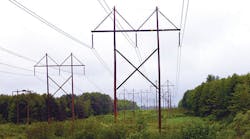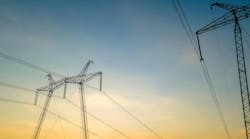Utility industry stakeholders are well aware of the potential dangers that outdated infrastructure can present. Utility Dive’s 2018 State of the Electric Utility report states that 67 percent of utilities believe that aging grid infrastructure remains a top issue among their companies. Many structures are around 50 years old and heavily vulnerable to breaks or inflicted damage. In the wake of experiencing the most expensive Atlantic hurricane season ever in 2016, totaling $202.6 billion in damages, it’s more crucial than ever for U.S. utilities to properly plan for potential storms or attacks, by ensuring the security and stability of their often-dated infrastructure. The following four practices are advised for utilities looking to take proactive steps in planning for resiliency:
1. Regularly Assess Utility Assets.
A main factor to consider when building any load-bearing structure is its ability to withstand everyday use and any potential inflicted damage. This depends on two components of the structure: strength and stability. It’s imperative that these characteristics remain priorities for utility manufacturers, to avoid or minimize any potential devastation in the future. According to the U.S. Energy Information Administration (EIA), this seems to be just the case, as utilities are continuing to increase spending on transmission infrastructure.
All utilities conduct periodic visual inspections of assets to collect information on their current state. Unlike other methods, these visual assessments don’t require special equipment or an outside professional, but do provide valuable supporting information and can indicate when more specialist intervention is required.
Testing can take it further and provide greater accuracy on exactly how much stress, time, and forces particular equipment or infrastructure elements can withstand. While it requires a specialty group with equipment, asset testing is the most definitive way to understand a structure’s current state, as well as what it’s capable of enduring. Testing should occur at many stages during a structure’s life, starting at when its framework is established. By doing so, companies are able to accurately know the strength and life span of their existing structures.
These tests can lead to direct benefits for utilities’ infrastructure. First, the analysis provides organizations the ability to conclusively know the current state of their assets. Instead of paying a significant amount of money to replace an entire piece of infrastructure, you can focus on only restoring impaired pieces, saving you money while keeping operations running efficiently. A utility in Texas recently conducted internal structure testing and discovered that their infrastructure only required new bracing, instead of needing to replace with entirely new H frames.
A type of test called destructive testing determines a structure’s strength and stability. It’s conducted by piling loads on a structure until it reaches failure, indicating the point when it’s met the maximum weight capacity. These results inform utilities on the current state of their infrastructure, and whether they need replacements of parts - ensuring safety and efficient operations. In the case of outdated infrastructure that isn’t economically worth replacing, utilities are still able to verify its strength and value. Testing provides a comprehensive approach for utilities to know, instead of guess, the strength and life of their structures.
2. Examine Supply Chain Sourcing.
Where do your infrastructure parts come from? When dealing with equipment responsible for powering local businesses and homes, it’s important to guarantee you’re using the highest-quality products, even if they’re not the cheapest. As is true with most products, there’s always a variety of offerings with varying product quality and costs. In the case of steel, a main component of utility infrastructure, there is a variety of available quality, often dependent on price. While purchasing steel from overseas manufacturers may be cheaper, the difference in quality, compared to American-made steel, can be detrimental to utility stakeholders. These products may not provide the level of stability and resilience necessary for utilities to operate confidently.
A product’s sourcing often determines its cost and lead time of their delivery. While both are significant factors for organizations, lead time can make a world of difference during a crisis. Last year in the wake of Hurricane Harvey, a Texas-based utility was able to channel a local vendor to quickly expedite 500 arms and hardware to their impaired structures. The vendors’ locality to the utility enabled them to adequately provide the needed materials in a timely manner.
3. Plan Ahead for Known Risks.
This step sounds obvious but cannot be overemphasized. Utilities must assess and prepare for the potential risks to their particular region, season, market, and challenges. With access to testing and assessment info (from steps 1-2), utilities will be equipped with a detailed understanding of their risks.
Is storm season fast approaching? Utilities should proactively prepare for these volatile weather episodes by communicating with their vendors and pre-purchasing products. By anticipating what materials will be needed for infrastructure restoration, utilities can proactively plan for resiliency by ensuring a smooth and prompt recovery with minimal outage time. Planning ahead of potential risks is key for a utility to ensure that it’s equipped to handle any outage issues customers may experience.
4. Think Holistically.
In situations where utilities are aware of incoming storms, it’s their responsibility to forecast the potential destruction of infrastructure and pre-purchase the necessary materials. Unless a storm is isolated in a particular area, it’s likely that multiple replacements of each part will be required to restore damage to the community’s utility infrastructure. Infrastructure manufacturers have begun to sell bundled structure kits for this particular reason, allowing customers to customize their kit with infrastructure parts based on their needs.
These bundled structure kits provide value, convenience and customization to utilities. The pre-packaging aspect has become exceedingly popular way to cut costs at utilities. Kits also provide a win-win for manufacturers and their customers by providing a simple method to transfer products in and out of inventory. The infrastructure manufacturers conveniently deliver these kits on-site at utilities, saving them time when they need to be preparing for an upcoming storm. For utilities looking to restore infrastructure in the quickest time possible, this on-site delivery process allows them to continue focusing on the ones most affected; their customers.
Sponsored By:



